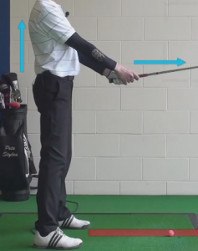
A marksman would not shoot a rifle at a target without first aiming his rifle.
To gain maximum accuracy, he utilizes the rifle's designed aiming technology. This principle directly applies to golf... After all, golf is a target game.
Time and time again, top professional instructors emphasize that misalignment of the golf shot is one of the most common errors, and golfers of all skill levels could lower their scores if they simply did a better job of aiming.
Every golf enthusiast understands the necessity of aiming the golf club for accuracy, and independent research confirms better club alignment improves accuracy and lowers scores. While this concept has been widely applied to putters – most of which feature built-in alignment aids -- shot alignment of irons and woods has been largely left up to the golfer.
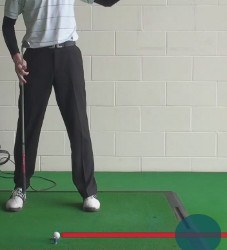 For a golf ball to travel on the intended path, the club must be aimed properly. If alignment of the club is not correct, the golfer's hands, arms, head, shoulders, hips, knees, and feet will attempt to compensate for the misalignment. This always leads to inconsistency.
For a golf ball to travel on the intended path, the club must be aimed properly. If alignment of the club is not correct, the golfer's hands, arms, head, shoulders, hips, knees, and feet will attempt to compensate for the misalignment. This always leads to inconsistency.
It's important for the golfer to start with the club properly aligned with the target, then align the body to the clubhead. This is the only way to consistently swing on plane and hit accurate shots.
Here's an easy procedure you should follow for every shot...
- Stand behind the ball and visualize a line between the ball and your selected target.

 Pinpoint a leaf or mark a few feet in front of the ball and on the target line.
Pinpoint a leaf or mark a few feet in front of the ball and on the target line.- Address the ball and aim the clubhead at the selected mark.
- The club is now aimed directly at the target. For a straight shot, align your body parallel to the target line and direction of the club head. Alignment of the body left of the line will create a fade or slice; lining up right will cause a draw or hook.
Now that your club and body are aligned properly, finish your normal routine and experience the advantages of increased consistency and accuracy.
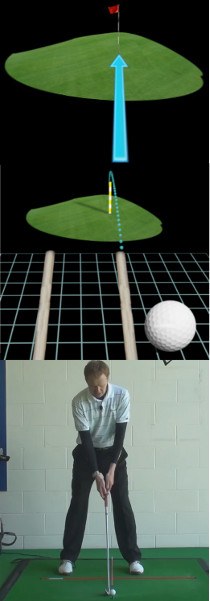
Why Shot Alignment is So Important
Golf is a game that comes down to hitting your targets. Sure, there are plenty of complicating factors along the way as you go around the course – things like slopes, wind, long grass, and more – but in the end you are simply trying to hit the ball as close to the target as possible over and over again. The golfers who are able to hit their targets in a reliable fashion tend to be the ones who are able to shoot the lowest scores, even if they aren't the longest hitters on the course.
Of course, making a quality golf swing is an important part of the equation when trying to hit your targets. However, there is more to this task than just making a great swing – you also need to be aligned properly before your swing even begins. This is a major problem for many amateur golfers, as the average player doesn't pay much attention to his or her setup before starting the swing. If alignment is a problem in your game, it won't matter how well you swing the club because the ball will already be destined to miss the target.
In this article, we are going to cover a number of points related to alignment. The idea behind alignment is to position your body in such a way that making a good golf swing will result in the ball winding up somewhere close to the target. While that might mean aiming directly at the target in some cases, it other cases it will mean aiming to the right or left slightly to account for a draw or fade as the ball flies. Perfect alignment for you is going to be different than for another player because your alignment needs to consider your own personal ball flight patterns. It will take plenty of effort and attention to get yourself into proper alignment at first, but this is a process that can become more and more natural with experience and practice.
If you fail to practice shot alignment when hitting balls on the driving range, you are always going to doubt your ability to aim out on the course. As you already know, doubt is a major problem in golf, as it can cause you to make poor swings even if you have built a solid technique during practice. You shouldn't be standing over the ball wondering whether or not you are aimed properly – you should be sure that your alignment is perfect so that your mind can focus on the task of executing a proper swing. Although you can't make a great swing each and every time simply due to the difficulty of this game, there is no reason you can't align yourself perfectly before each shot. Getting alignment right comes down to preparation and practice – give this area of golf the attention it deserves and you surely will be rewarded.
All of the instruction below is written from the perspective of a right handed golfer. If you happen to play left handed, please take a moment to reverse the directions as necessary.
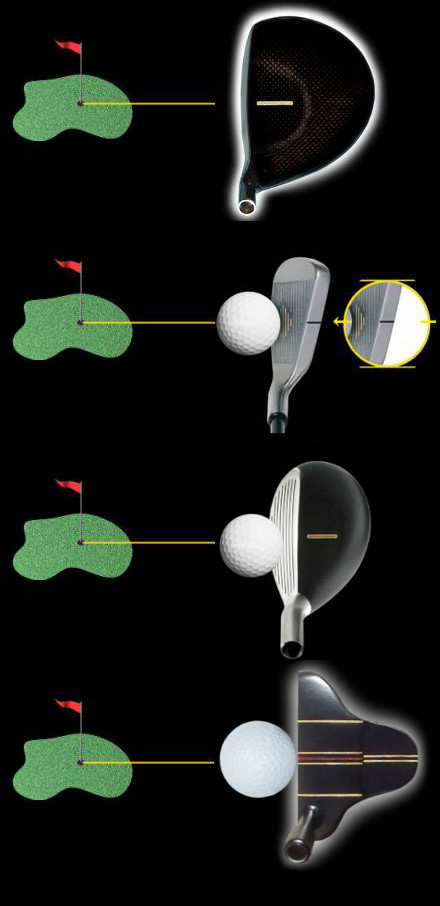
Target Clarity
One of the biggest problems when it comes to alignment doesn't actually have anything to do with the way you take your stance – it has to do with the way you think before getting ready to hit a shot. Simply put, you need to make sure you are selecting a clear and specific target for each and every shot you hit as you move around the course. Golf is a target game, and yet countless amateur golfers never really a pick a target as they play. Instead, they just aim for the 'fairway' or the 'green' and hope for the best. That isn't going to be good enough, and you are going to need to get very specific with your targets if you wish to improve.
Picking a target is one of the first things you should be doing when you arrive at your next shot. In fact, before even picking out a club, you should be assessing the situation and deciding what you are going to use as your target. If playing an approach shot, for example, are you going to aim directly at the flag? Sometimes that will be a good idea, but other times you will need to aim away to the right or left slightly in order to give yourself some margin for error. After all, it would be foolish and risky to aim directly at the flag when the hole is only a few steps from a water hazard – in that case, adjusting your target away from the water is going to be the smart move. Only when you have a clear target in mind should you proceed with picking a club and getting ready to swing.
While you might already do a decent job of picking targets on your approach shots, there is a good chance that your target identification skills from the tee could use some serious work. Most players just walk up to the tee, aim down the middle of the fairway, and swing away. Or, perhaps, they will adjust slightly to aim down the right or left to allow for a draw or fade. However, there is very little thought given to anything other than just trying to get the ball in the short grass.
If you want to play at a higher level, you are going to need to revise your thinking to include strategy from the tee. Of course you would like to be in the fairway, but what part of the fairway looks best? Is there one side of the fairway that is going to give you a better angle than the other for your approach shot? Are there any hazards guarding the sides of the fairway that need to be avoided? Each shot you hit on the golf course has a strategic element, and that includes all of your tee shots. It is tempting to just 'grip it and rip it' when you step up onto the tee, but taking time to pick a strategic target is going to give you a much better chance to succeed.
To make it easier to pick out specific targets for your shots, one of the skills you can add to your game is the ability to spot objects in the distance that you can use as target lines. When aiming to a specific part of the fairway, for example, you might have a tough time finding something visually that you can use to serve as your target. After all, a fairway is just a big field of grass, so it probably all looks the same from the tee. However, if you bring your eyes up to the horizon, you should find any number of objects on an extension of your target line that can be used as guides. Depending on where you are playing, you can use trees, bushes, buildings, and more to substitue as targets. These targets will be well out of the reach of your shots, of course, but they will help you to focus in on the proper line as you are taking your stance.

The Railroad Track Concept
When you think about setting up to hit a shot, you probably first think about setting your feet into a good position to make the swing. While the feet are certainly important, they are not actually the first thing to consider – instead, you need to think first about the club head, and then about your feet. Why? Because if you use your feet to establish your stance and get lined up, you will inevitably wind up aiming to the right of your intended target.
It is best to think about this issue in terms of train tracks. Obviously, a set of train tracks runs parallel to one another, heading in the same direction but on slightly different lines. Those lines never cross, but rather they remain parallel for the entire length of the track. The idea is much the same when it comes to setting up for a golf shot. Imagine that the line formed by your feet is one side of the tracks, while the line you point the club face down is the other side. These two lines are parallel to one another, and they remain that way all the way to the target.
So, what happens if you aim your feet at the target? The line that the club head is using will be automatically aimed to the right of the spot you had picked out for the shot. To align yourself properly, you actually need to set your feet on a line that is parallel to the left of your chosen target. It is the club head, not your feet, that needs to be aimed perfectly at the target you selected. This might seem like a subtle point, but it is tremendously important to your success on the course. Countless amateur golfers make the mistake of aligning their feet with the target rather than the club, and they miss out to the right consistently as a result.
To overcome this common problem, you need to get into the habit of setting your club prior to setting your feet while taking your stance. As you walk up to the ball, the first action you take should be placing your club head behind the ball in a position that aligns the face with the target perfectly. Only after you have positioned the club head should you then go ahead and set your feet into place. Again, this is something that seems minor but can have a major impact on the accuracy of your shots. During your next practice session, try resetting your stance after every shot by using the process highlighted in this paragraph. Walk up to the ball, set the club, then set your feet, and hit the shot. Doing this over and over again during practice will make it much easier to execute correctly on the course.
If you are used to aiming right when playing most of your shots, setting yourself up in proper alignment with the target is going to seem strange at first. You will likely feel as though you are aimed way to the left, even though you are right on track. It is going to take some time to adjust the way your eyes relate to the target at address before you can feel confident that you are set up correctly. Like so many other things in golf, this is where practice becomes so important. By spending time on the practice range working specifically on your alignment, you can quickly become more comfortable with how your body should be positioned. Where it might take you several rounds on the course to adjust to this new setup, it should only take a couple of practice sessions to make the change.

Adjusting for Your Ball Flight
To this point, everything we have talked about has mostly assumed that you are going to be hitting the ball straight. Of course, there is a problem with that assumption – it is nearly impossible to actually hit a golf ball straight for the length of its flight. Even professional golfers don't usually try to hit the ball straight, as there is almost always a degree of curve built in to their shot plans. Therefore, we are going to need to add another variable to this equation before it is complete, as you are going to have to adjust your aim to account for the way the ball is expected to curve in the air.
Before you can adjust your aim based on your ball flight, you need to know what that ball flight looks like in most cases. Unfortunately, you aren't really going to be able to judge your ball flight accurately on the driving range, as the golf balls that are used on most ranges do not behave the same way as a ball that you would use on the course. So, the only way to get accurate information about your ball flight is to play as much golf as possible while carefully monitoring the patterns that you see develop.
It is important to note that you may have a dramatically different ball flight between your woods and your irons, so don't assume that one shot pattern is going to carry throughout your bag. You may wish to keep a notebook in your bag where you record all of your shot shapes to help you remember each shot over the course of several rounds. After a few rounds of note taking, you should have a clear picture of the kinds of shots your swing produces.
Once you have a clear understanding of how your ball likes to curve in the air, you will then be able to adjust your alignment accordingly before making a swing. The process should work as follows –
- To start, you are going to pick your target just as you would prior to any shot that you hit. This target is the place where you want the ball to finish – it has nothing to do with the path that the ball is going to take on its way. For a short wedge shot, your target will very likely be the hole itself. On a tee shot, you may pick a spot in the left side of the fairway, or any other location depending on the strategy you wish to use.
- Once your target has been selected, the next job is to pick a club. Think about the distance that you are facing, along with conditions like wind and temperature to settle on the right club. It is important that you are confident in your selection, so only move past this point when you are sure that you have the right club in hand.
- Now is the time when you are going to adjust your aim for any curve that you expect the ball to have as it flies. Before you walk up to take your stance, picture your intended ball flight and determine how much to the right or left of the target you need to aim. Most likely, you will need to play for more curve on longer shots and less curve on shorter ones. This adjustment can only be made accurately through practice and experience, as no one else is going to be able to tell you exactly how much curve to expect.
- With your ball flight decision made, you are now going to walk up to the ball and place your club head down at address in a way that aligns it with the path you have selected. Remember, you aren't going to point the club face directly at your target (unless you expect to hit the ball in a straight line). Set the club face on a line that will allow you to curve the ball back to the target successfully. With the club set, move your feet into place, take a last look at the target, and swing away.
Golf would be simple – and probably a little bit boring – if the ball always flew in a straight line. It doesn't, of course, so you are going to need to learn how to adjust for your various ball flights prior to aligning your stance each time. This is always going to be one of the trickiest parts of the game to get just right, but you should dramatically improve over time.
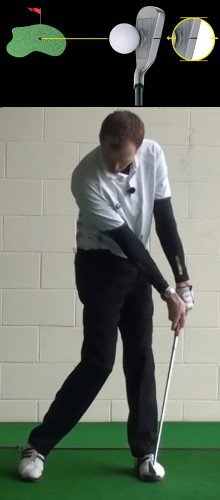
Alignment in the Short Game
Aligning your body for short game shots is significantly easier than setting up to make a full swing. There aren't as many variables present in the short game, so you should be able to get this process down to a science with just a little bit of practice. For one thing, the ball isn't going to curve in the air when playing short shots, so you don't have to worry about that adjustment – you can simply aim directly at your target every time (the ball will break from side to side as it rolls, of course, but that is a different kind of adjustment). Also, since you are standing so much closer to the hole in the short game, you can easily see the target that you have picked out for your shot.
For most players, the best way to get aligned in the short game is to pick out a spot on the green to use as the target. For chip shots, this spot is going to be your landing spot – the point on the putting surface where the ball will (hopefully) land before bouncing and rolling out toward the cup. When putting, your target spot should be just a few inches in front of the ball on a line that you think will allow the putt to break into the hole. By using a target that is barely in front of the ball, you can get aligned properly without any trouble since everything you need to see will be well-within your field of vision.
It is important to remember that the railroad tracks concept still applies to the short game, so you need to have your club face aligned with the target rather than your feet. In fact, you don't even have to place your feet in a square position at address. If you would rather stand a bit open or closed to the line to make your swing and stance more comfortable, that is perfectly fine. As long as the club face is square to the target, and as long as you can swing down the line time after time, you should be well on your way to success.
Alignment is not something that you will hear golf commentators talking about on TV very often, because it certainly isn't one of the more-exciting aspects of the game. However, it is extremely important to playing well, whether you are top professional of the average amateur. Take some time during your upcoming practice sessions to work on alignment and your game will benefit in the end.


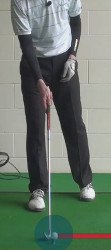
 Pinpoint a leaf or mark a few feet in front of the ball and on the target line.
Pinpoint a leaf or mark a few feet in front of the ball and on the target line.



